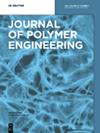A brief review on polymer nanocomposites: current trends and prospects
IF 1.7
4区 工程技术
Q4 POLYMER SCIENCE
引用次数: 0
Abstract
Abstract Nanoparticles (NPs) are being incorporated into pristine polymeric matrices as well as recycled waste polymers to prepare new materials with enhanced properties called polymer nanocomposites (PNCs). There has been an accelerating growth in the field of polymer nanocomposites in the last two decades owing to their tunable and enhanced optical, thermal, electrical, magnetic, and mechanical properties, which make them viable and well-suited for various applications. The addition of nanoparticles in the form of nanosheets, nanotubes, nanospheres, quantum dots, etc., to the polymer matrices reduces the drawbacks of polymers like low mechanical strength, weaker chemical resistivity, etc. due to the large surface area to volume ratio of NPs. Moreover, the interaction of nanoparticles with the polymer chain lowers the permeability of gases and increases the water resistance of the polymer. Due to their remarkable capabilities, polymer nanocomposites have attracted significant theoretical interest as well as a large number of practical applications in a variety of scientific and technological domains. This article provides an overview of the various classes of nanoparticles and different fabrication methods used to produce polymer nanocomposites. Additionally, an effort is made to comprehend the properties and applications of polymer nanocomposites in different areas like wastewater treatment, dye removal, heavy metal and gas sensing, optoelectronics, etc.聚合物纳米复合材料研究现状与展望
摘要纳米颗粒(NP)被掺入原始聚合物基质和回收的废弃聚合物中,以制备具有增强性能的新型材料,称为聚合物纳米复合材料(PNCs)。在过去的二十年里,由于聚合物纳米复合材料的光学、热学、电学、磁学和机械性能的可调性和增强性,使其具有可行性并非常适合各种应用,因此聚合物纳米复合物领域的发展速度加快。将纳米片、纳米管、纳米球、量子点等形式的纳米颗粒添加到聚合物基体中,减少了聚合物的缺点,如由于纳米颗粒的大表面积与体积比而导致的低机械强度、较弱的化学电阻率等。此外,纳米颗粒与聚合物链的相互作用降低了气体的渗透性,并增加了聚合物的耐水性。聚合物纳米复合材料由于其卓越的性能,在各种科学技术领域引起了极大的理论兴趣和大量的实际应用。本文概述了用于生产聚合物纳米复合材料的各类纳米颗粒和不同的制备方法。此外,还努力了解聚合物纳米复合材料在废水处理、染料去除、重金属和气体传感、光电子等领域的性能和应用。
本文章由计算机程序翻译,如有差异,请以英文原文为准。
求助全文
约1分钟内获得全文
求助全文
来源期刊

Journal of Polymer Engineering
工程技术-高分子科学
CiteScore
3.20
自引率
5.00%
发文量
95
审稿时长
2.5 months
期刊介绍:
Journal of Polymer Engineering publishes reviews, original basic and applied research contributions as well as recent technological developments in polymer engineering. Polymer engineering is a strongly interdisciplinary field and papers published by the journal may span areas such as polymer physics, polymer processing and engineering of polymer-based materials and their applications. The editors and the publisher are committed to high quality standards and rapid handling of the peer review and publication processes.
 求助内容:
求助内容: 应助结果提醒方式:
应助结果提醒方式:


